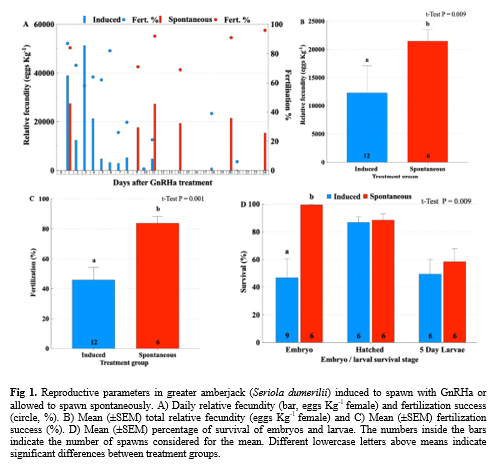SPONTANEOUS SPAWNING OF CAPTIVE GREATER AMBERJACK Seriola dumerilii REARED IN SEA CAGES AND TRANSFERRED TO LARGE TANKS DURING THE SPAWNING SEASON
Introduction
Up to date, the most effective method to obtain good quality eggs from Mediterranean greater amberjack ( Seriola dumerili ) has been to (a) maintain breeders in sea cages during the year - where they undergo full gametogenesis - and then (b) move them to land-based tanks after gonadotropin-releasing hormone agonist (GnRHa) induction of spawning
. In order to reduce the reliance of the industry on the usage of hormonal treatments for spawning induction, and potentially also improve egg quality parameters , we examined the hypothesis that using large diameter tanks for spawning, would allow spontaneous maturation and spawning of fully vitellogenic females and spermiating males.
Materials and Methods
Reproductively mature breeders were maintained in a sea cage over the year and were transferred to two 75-m3 tanks supplied with filtered surface seawater for the spawning period . Fish were selected based on evaluation of ovarian biopsies and sperm production. In the first tank, fish were given (GnRHa) in a controlled release implant (Induced , six males of mean ± SD weight of 22.1 ± 1.6 kg , and four females of 25.0 ± 2.03 kg). In the second tank ( Spontaneous, five males of 19.0 ± 0.56 kg and four females of 29.7 ± 0.92 kg) , fish did not receive any hormonal treatment . Reproductive success was evaluated through fecundity and fertilization success. Computer-assisted sperm analysis (CASA) was used to assess sperm quality of the selected males. Statistical analyses were done using t-test or two-way ANOVA (P £ 0.05).
Results
The mean oocyte diameter of the largest vitellogenic oocytes was 675 ± 38 and 645 ± 16 for the Induced and Spontaneous group respectively. Some females in each tank were in early oocyte maturation (lipid droplet coalescences and germinal vesicle migration). These females presumably were the ones that spawned the next day. Females treated with GnRHa spawned 12 times, out of which 8 were the following days after hormonal therapy (Fig. 1A). On the contrary, the Spontaneous group spawned less frequently for a total of 6 times (Fig. 1A). The mean spawning batch relative fecundity (t-test, P = 0.009) (Fig. 1B) and fertilization success (t-test, P = 0.001) (Fig. 1C) of the Spontaneous group were higher than the Induced group. Additionally, embryo survival of eggs from the Spontaneous group reached 99 ± 0.3% and was also significantly different than from the GnRHa-induced group (t-test, P = 0.009) (Fig. 1D). Sperm quality parameters diminished after 24 days in the spawning tanks, in both GnRHa-treated and non-treated males (two-way ANOVA, P £ 0.05).
Discussion
Inappropriate environmental conditions in captivity may lead fish to exhibit reproductive dysfunctions (Mylonas et al., 2010). P roviding greater amberjack with a large-volume tank, allowed spontaneous and consistent spawning with excellent fecundity , fertilization and embryo survival, which were higher than the values obtained from GnRHa-induced breeders . Sperm quality parameters after 24 days were similar between GnRHa-treated and non-treated males, indicating also in the males, that allowing greater amberjack to spawn in large tanks is supportive of reproductive performance.
Acknowledgements
Financial support has been provided by the European Union’s Horizon 2020 program under grant agreement No 862658 , NEWTECHAQUA).
References
Fakriadis, I., Lisi, F., Sigelaki, I., Papadaki, M., Mylonas, C.C., 2019. Spawning kinetics and egg/larval quality of greater amberjack (Seriola dumerili)in response to multiple GnRHa injections or implants. Gen. Comp. Endocrinol. 279, 78–87. https://doi.org/10.1016/j.ygcen.2018.12.007
Fakriadis, I., Sigelaki, I., Papadaki, M., Papandroulakis, N., 2020. Control of reproduction of greater amberjack Seriola dumerili reared in aquaculture facilities. Aquaculture 519, 734880. https://doi.org/10.1016/j.aquaculture.2019.734880
Mylonas, C.C., Fostier, A., Zanuy, S., 2010. General and Comparative Endocrinology Broodstock management and hormonal manipulations of fish reproduction. Gen. Comp. Endocrinol. 165, 516–534. https://doi.org/10.1016/j.ygcen.2009.03.007
